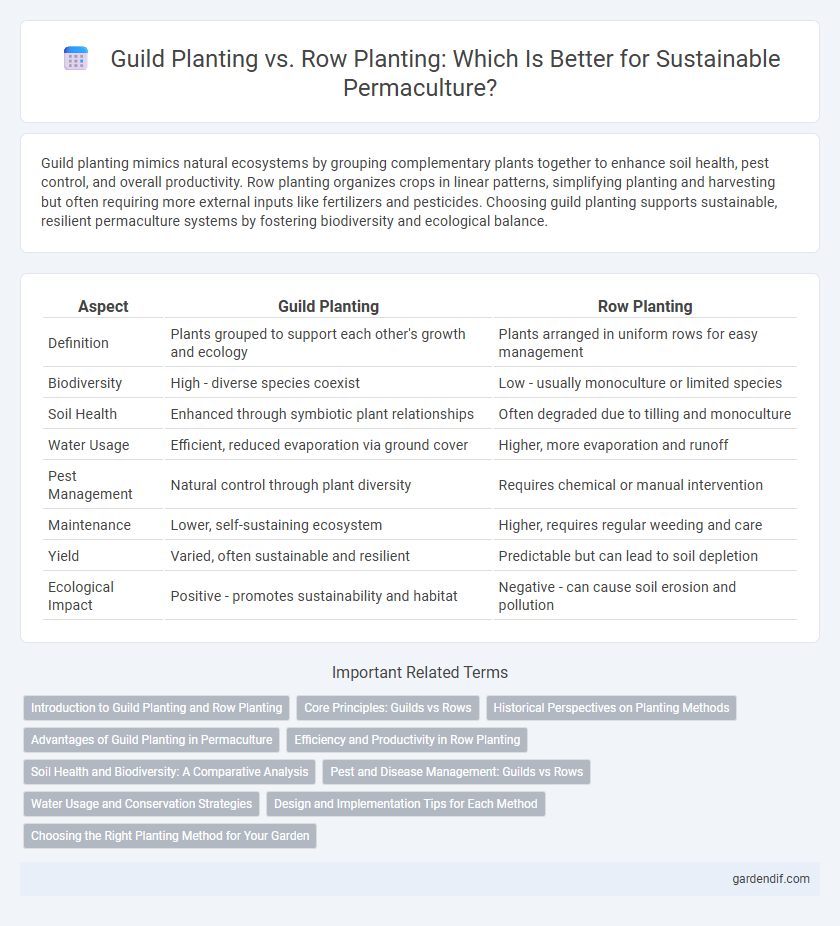
Guild Planting vs Row Planting Illustration
Guild planting mimics natural ecosystems by grouping complementary plants together to enhance soil health, pest control, and overall productivity. Row planting organizes crops in linear patterns, simplifying planting and harvesting but often requiring more external inputs like fertilizers and pesticides. Choosing guild planting supports sustainable, resilient permaculture systems by fostering biodiversity and ecological balance.
Table of Comparison
| Aspect | Guild Planting | Row Planting |
|---|---|---|
| Definition | Plants grouped to support each other's growth and ecology | Plants arranged in uniform rows for easy management |
| Biodiversity | High - diverse species coexist | Low - usually monoculture or limited species |
| Soil Health | Enhanced through symbiotic plant relationships | Often degraded due to tilling and monoculture |
| Water Usage | Efficient, reduced evaporation via ground cover | Higher, more evaporation and runoff |
| Pest Management | Natural control through plant diversity | Requires chemical or manual intervention |
| Maintenance | Lower, self-sustaining ecosystem | Higher, requires regular weeding and care |
| Yield | Varied, often sustainable and resilient | Predictable but can lead to soil depletion |
| Ecological Impact | Positive - promotes sustainability and habitat | Negative - can cause soil erosion and pollution |
Introduction to Guild Planting and Row Planting
Guild planting arranges complementary plants together to mimic natural ecosystems, enhancing soil health, pest control, and productivity through beneficial interactions. Row planting organizes crops in linear patterns for easy access and management but often lacks biodiversity and ecological synergy found in guild systems. Choosing guild planting supports sustainable permaculture by fostering symbiotic relationships, while row planting favors traditional agricultural efficiency.
Core Principles: Guilds vs Rows
Guild planting integrates diverse species with complementary functions like nitrogen fixation, pest control, and nutrient accumulation, fostering a self-sustaining ecosystem. Row planting emphasizes monoculture or single-crop sequences, aimed at maximizing space efficiency and simplified management but often requiring external inputs. The core principle of guilds centers on ecological synergy and biodiversity, contrasting with rows' focus on order and ease of mechanization.
Historical Perspectives on Planting Methods
Guild planting, rooted in indigenous and ancient agricultural traditions, emphasizes biodiversity and symbiotic plant relationships to enhance soil health and pest resistance. Row planting, developed during the rise of industrial agriculture, prioritizes mechanization and uniform crop management, often leading to soil depletion and reduced ecosystem stability. Historical shifts from guild to row planting reflect broader changes in agricultural practices, driven by technological advances and market demands.
Advantages of Guild Planting in Permaculture
Guild planting in permaculture enhances biodiversity by combining complementary plants that support each other's growth, improving soil health, pest control, and nutrient cycling. This method reduces the need for synthetic inputs by naturally attracting beneficial insects and promoting disease resistance within the plant community. Guild planting increases overall system resilience and yield compared to traditional row planting by creating a self-sustaining ecosystem.
Efficiency and Productivity in Row Planting
Row planting optimizes efficiency by simplifying crop management, irrigation, and harvesting through structured spacing, allowing for mechanization and easy access. This method increases productivity by maximizing sunlight exposure and minimizing competition among plants, leading to uniform growth and higher yields. In comparison to guild planting, row planting supports large-scale agricultural operations with streamlined workflows and consistent output.
Soil Health and Biodiversity: A Comparative Analysis
Guild planting enhances soil health by promoting diverse root structures that improve nutrient cycling and soil aeration, whereas row planting often leads to soil compaction and reduced microbial activity due to monoculture practices. The biodiversity in guild systems supports beneficial insects and microorganisms, creating resilience against pests and diseases, unlike row planting which typically diminishes habitat variety and ecosystem stability. Integrating multiple species in guild planting fosters a sustainable environment with balanced soil ecosystems compared to the nutrient depletion commonly observed in row-based monocultures.
Pest and Disease Management: Guilds vs Rows
Guild planting enhances pest and disease management by creating biodiverse ecosystems that attract beneficial insects and promote natural pest suppression. Rows, with their monoculture approach, often suffer from higher pest and disease incidence due to reduced biodiversity and limited habitat for predators. Integrating guild planting practices reduces reliance on chemical controls and supports healthier, more resilient plant communities.
Water Usage and Conservation Strategies
Guild planting enhances water conservation by creating a self-sustaining ecosystem where plants with complementary water needs grow together, promoting efficient moisture retention and reducing evaporation. Row planting typically involves monoculture with exposed soil surfaces, leading to higher water runoff and increased irrigation demand. Utilizing guild planting strategies like mulching and companion planting optimizes water usage by maximizing soil cover and natural irrigation cycles.
Design and Implementation Tips for Each Method
Guild planting emphasizes biodiversity by combining complementary plants in a single area to enhance soil health, pest control, and overall productivity, making it ideal for creating self-sustaining ecosystems. In contrast, row planting focuses on systematic, easy-to-manage crops arranged in parallel lines, which simplifies planting, maintenance, and harvesting processes, especially for large-scale production. For guild planting, prioritize selecting compatible species and layering plants vertically, while row planting benefits from precise spacing and uniform crop selection to optimize sunlight exposure and irrigation efficiency.
Choosing the Right Planting Method for Your Garden
Selecting the appropriate planting method, such as guild planting or row planting, depends on your garden's goals and ecosystem. Guild planting enhances biodiversity and fosters plant relationships that improve soil health and pest control, ideal for permaculture practitioners seeking sustainability. Row planting suits large-scale or highly mechanized gardens where ease of access and uniformity are priorities.
Guild Planting vs Row Planting Infographic

 gardendif.com
gardendif.com